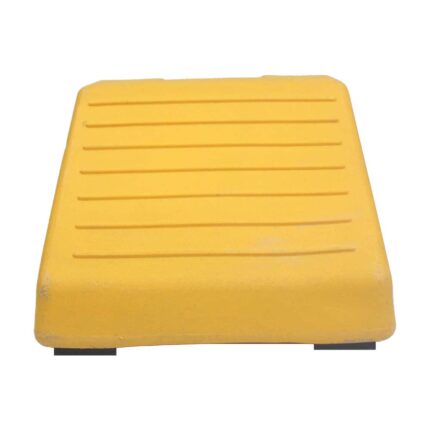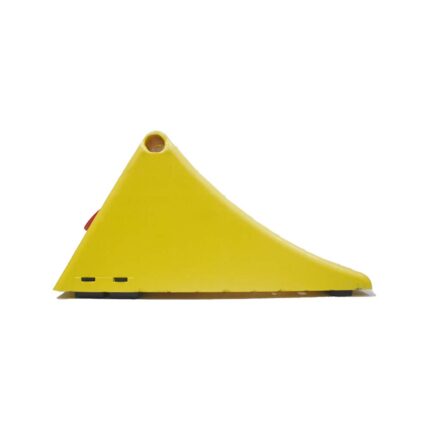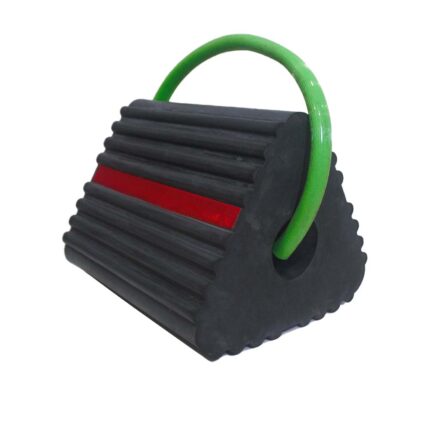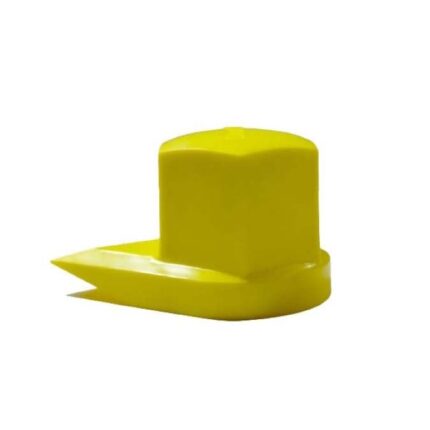The wheel chock is constructed of reinforced rubber to provide a sure grip on virtually any surface.
- Curved surface contours to fit tires. Rubber resists tearing, abrasion, ozone weathering, etc.
- Functional design is durable in all weather conditions.
- The chock is suitable for small and large vehicles.
- Prevent runway vehicle accidents with Wheel Chocks.
- The wheel chocks are ideal for off-highway construction equipment, Buses, Trailers, Lorries, Earth moving & other heavily loaded vehicles.
- The Wheel chock is attached with nylon rope & grip handle for easy handling.
- We have introduced this design first time in India.
Did you know that military cargo planes are chocked on the runway? Conventional wisdom would suggest that such a massive piece of military hardware would have a parking brake that is more than adequate to do the job, but the fact is, it’s standard procedure to take no chances with military aircraft. The same mentality should apply to your operation. Any time trucks or other heavy equipment are required to be parked, and/or raised (especially trailers and truck beds) you should invest an extra few seconds to place chocks for the additional safety factor.
Do you know what the U.S. Department of Labor guidelines are for wheel chocks? A truck or trailer must be equipped with them (rear wheels only) for any use at a loading dock, unless mechanical means are used to prevent the truck or trailer from moving during an unloading or loading procedure. Chocks may be optional safety features for a crane, forklift, or dump truck, but for trailers and trucks, they are mandatory if there is no mechanical assistance to prevent trailer creep.
There are hundreds of uses for wheel chocks; everything from trucks to military aircraft to rail cars. Wheel Chocks prevent accidental movement or slippage of heavy vehicles. This is especially important during loading and unloading–the shifting weight can affect wheel placement unless chocks are used to stabilize the vehicle.
Use chocks along with truck restraints in dock areas for an added safety measure. There are many different sizes and materials to choose from–you may wish to use the rubber chocks when dealing with certain conditions–especially cold or wet areas, or the aluminum chocks in other situations including an indoor garage or warehouse situation where cold temperatures are not an issue.
Wheel chocks are required by OSHA, and in order to be in compliance you will have to insure that every truck that comes into the dock area is chocked during the unloading or loading process. If you are relying on the honor system after having posted signage and providing chocks, you are taking a serious risk. Not all operators are equally conscientious, and a few bad apples will take advantage of reduced visibility in the dock area to avoid the additional hassle of placing the chocks. Doing so puts your company at risk, and you will need to take additional measures to enforce compliance with OSHA regulations.
Strategically placed cameras are an excellent incentive for an operator to comply, but many companies are unwilling to invest in expensive camera systems. Fortunately, a strategically placed mirror and an observant dockworker can get the same job done as a camera. No matter which solution is best for you, compliance is the key to avoiding liability.
The advantage of a set of rubber chocks is obvious to anyone who has ever picked up an aluminum chock in freezing / hot temperatures. Rubber is weatherproof, scratch resistant, and best of all, doesn’t freeze your hands when you pick it up in the cold!
A rubber wheel chock is designed to be non-slip, and chocks are required by OSHA to be used with rail cars and trucks during loading/unloading. If you are considering a set of chocks, compare the price of the rubber wheel chock with those made of other materials. We also Provide Caution/ Warning Reflective sticker.
Trailer wheel chocks are required by the Department of Labor’s Occupational Safety & Health Administration (OSHA) for all loading and unloading operations. Additionally, the use of trailer wheel chocks is an excellent backup for other dock safety devices.
You may wish to put trailer wheel chocks on any trailer not in use at the moment as an added safety measure. The trailer wheel chock is an investment that will increase workplace safety. Better safe than sorry!
Click here for Full OSHA Details
To properly use wheel chocks, it’s important to remember a few basic guidelines:
1. Always use chocks in pairs, especially if you are unsure of the slope of a roadway, parking area, or other terrain. It’s often a good idea to purchase chocks that are connected one to another.
2. Always place the chocks snugly against the tires, and beware wet surfaces that can allow chocks to slip under the wrong conditions.
3. If you are parked on an oily surface, move the vehicle to a safer spot, if possible.
4. Never drive over chocks, or try to apply chocks if the parking brake has not been applied.
5. Remember that improper use of chocks can void warranties, insurance, and compliance to safety regulations.
- Wedges tires to restrict movement
- Heavy duty fiber reinforced recycled rubber construction
- Carrying handle for easy handling
- Fits various diameter tires and up
- Rubber creates anti-slip surface
- Resistant to oils, fuels, and solvents
- Mounting hole for rope.
- Bottom void
- Improper use may result in product failure
- Select wheel chock according to vehicle type and size
- Always use in pairs and on firm surfaces
- Chock in direction of grade
- Chock both sides of wheel if direction of grade is undetermined
- Use only after parking brake is applied and tested
- Center chocks snugly and squarely against tread of each wheel
- Always test chocks to insure they meet requirements
- Do not drive over wheel chocks




